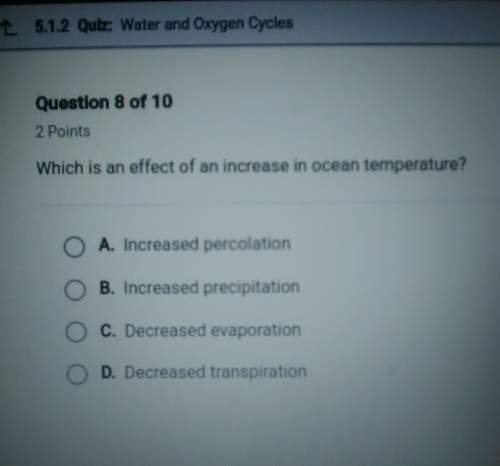⚠️this is multiple-choice⚠️
select all of the accurate statements.
a. cellul...

Biology, 05.11.2019 03:31 nshadow2920
⚠️this is multiple-choice⚠️
select all of the accurate statements.
a. cellular respiration is an example of conservation of energy.
b. cellular respiration is a physical change.
c. cellular respiration is a change of the state of matter.
d. cellular respiration is an example of conservation of mass.
e. cellular respiration is a chemical change.

Answers: 2


Another question on Biology

Biology, 21.06.2019 19:30
Which statement is true about the cell theory? a) it is well-supported by evidence. b) it is unchangeable and permanent.
Answers: 2

Biology, 21.06.2019 19:30
Are these strong bases, neutral, strong acids, weak acids or weak base household bleach (ph=12.6) fluid in a car's battery (ph of less than 1.0) milk (ph=6.7) stomach contents (ph=2.2) pure water (ph=7)
Answers: 1

Biology, 22.06.2019 01:00
If water were a non polar molecule, how would its properties be different ? a.) water would be a much lighter molecule b.) water would be able to climb up inside plants c.)water would not be able to form hydrogen bonds d.) water would stick together much more strongly
Answers: 2

Biology, 22.06.2019 01:30
Scenario 5 1) take 10 red and 10 black beans and place them, mixed, on the table. record the starting phenotype # and frequencies (% of your total population) of your starting population in the table provided (generation 0). 2) act as a predator. “capture” as many organisms as you can until you have reduced the population to three organisms. put them aside. at this point, the predators die. 3) the remaining organisms each produce 2 clonal offspring. multiply your organisms accordingly and allow them to mix on the table. calculate and record the resultant phenotype # and frequencies (% of your total population) of your population in the table provided (generation 1). 4) repeat the reproduction event, allowing each of your organisms to produce 2 clonal offspring. calculate and record the resultant phenotype # and frequencies (% of your total population) of your population in the table provided (generation 2). 5) repeat the reproduction event, allowing each of your organisms to produce 2 clonal offspring. calculate and record the resultant phenotype # and frequencies (% of your total population) of your population in the table provided (generation 3).
Answers: 1
You know the right answer?
Questions


History, 25.05.2021 07:40



Mathematics, 25.05.2021 07:40

Mathematics, 25.05.2021 07:40


Computers and Technology, 25.05.2021 07:40



History, 25.05.2021 07:40

Mathematics, 25.05.2021 07:40

Mathematics, 25.05.2021 07:40


Chemistry, 25.05.2021 07:40


Mathematics, 25.05.2021 07:40

Mathematics, 25.05.2021 07:40

English, 25.05.2021 07:40




